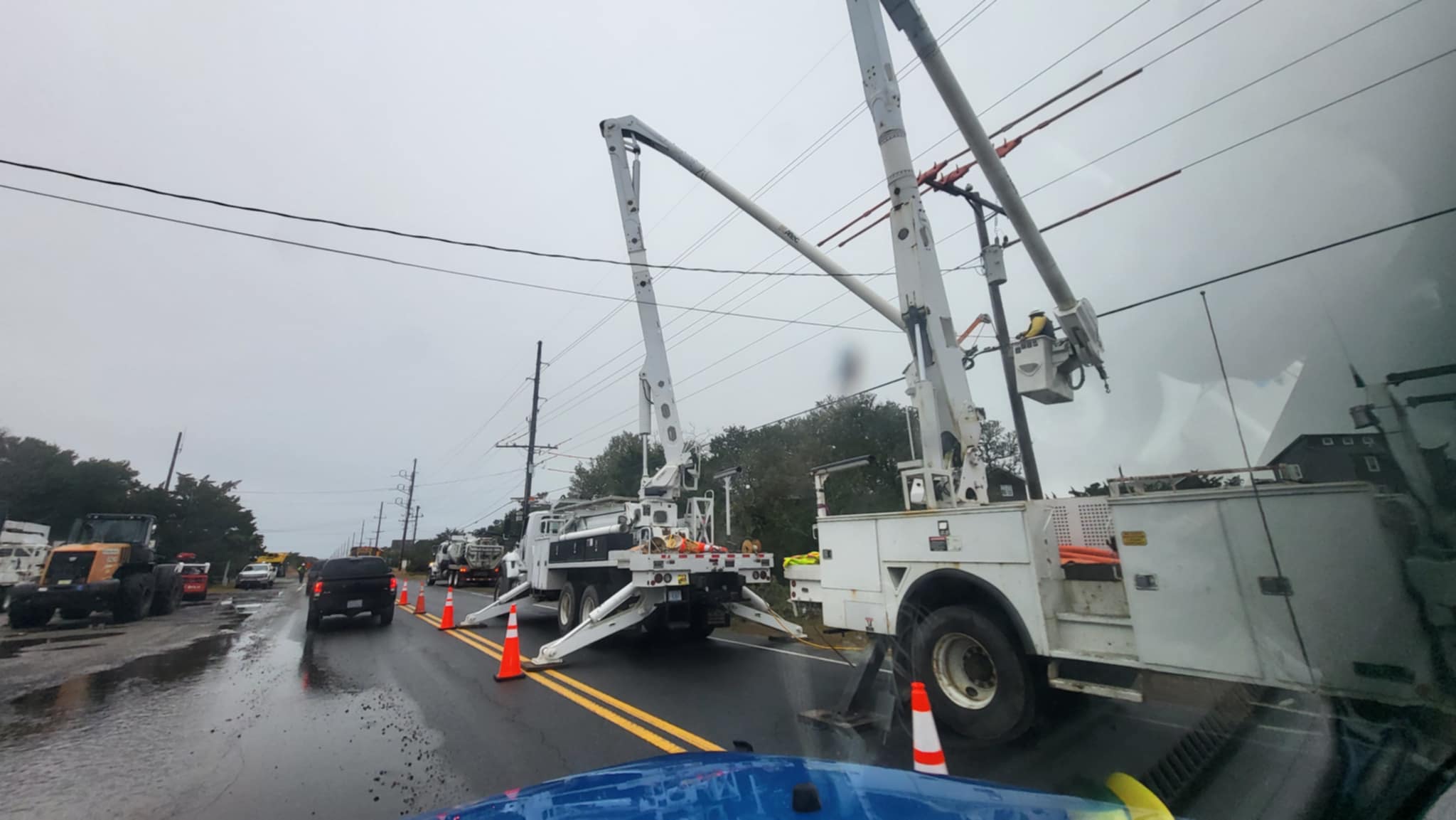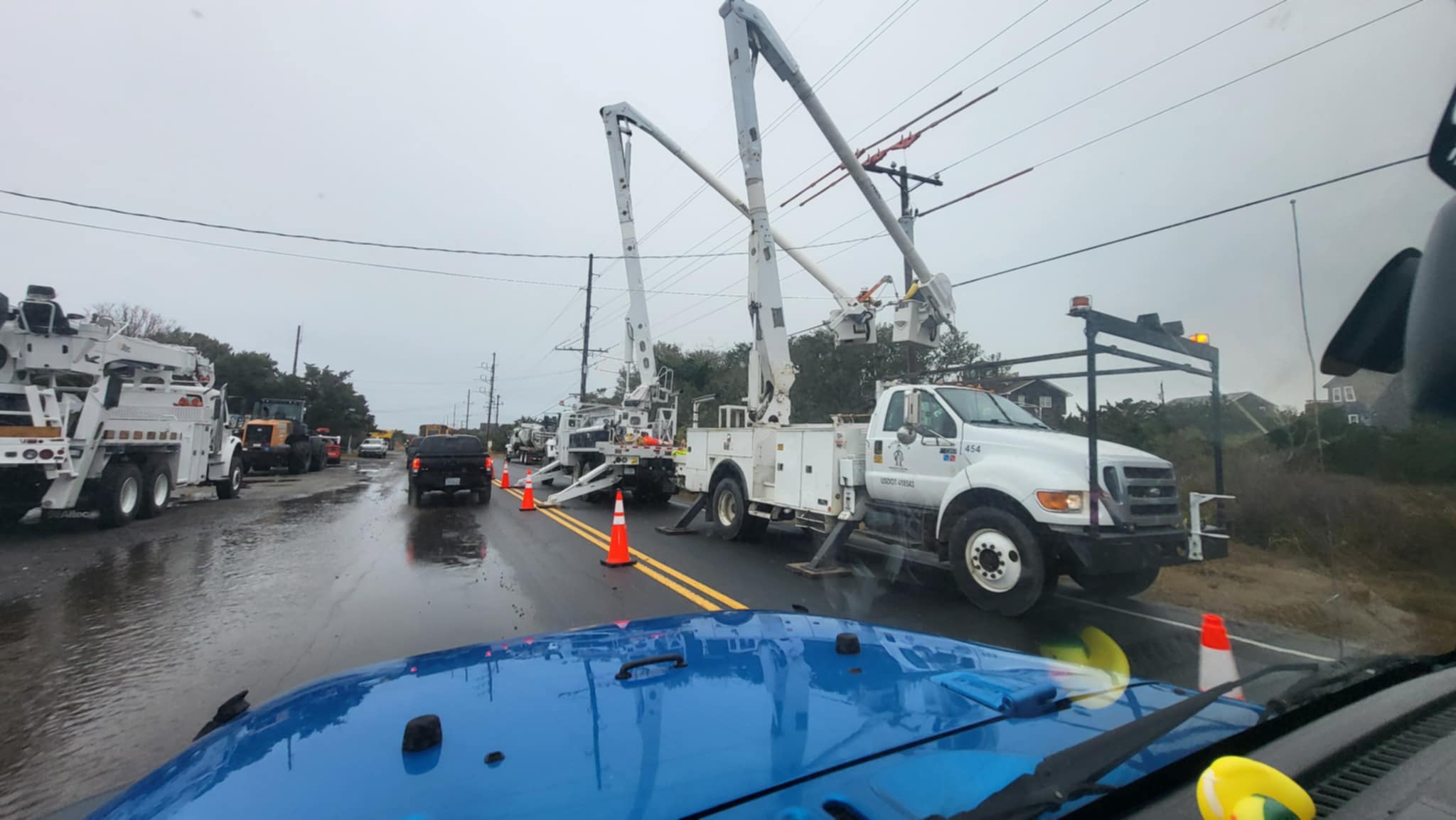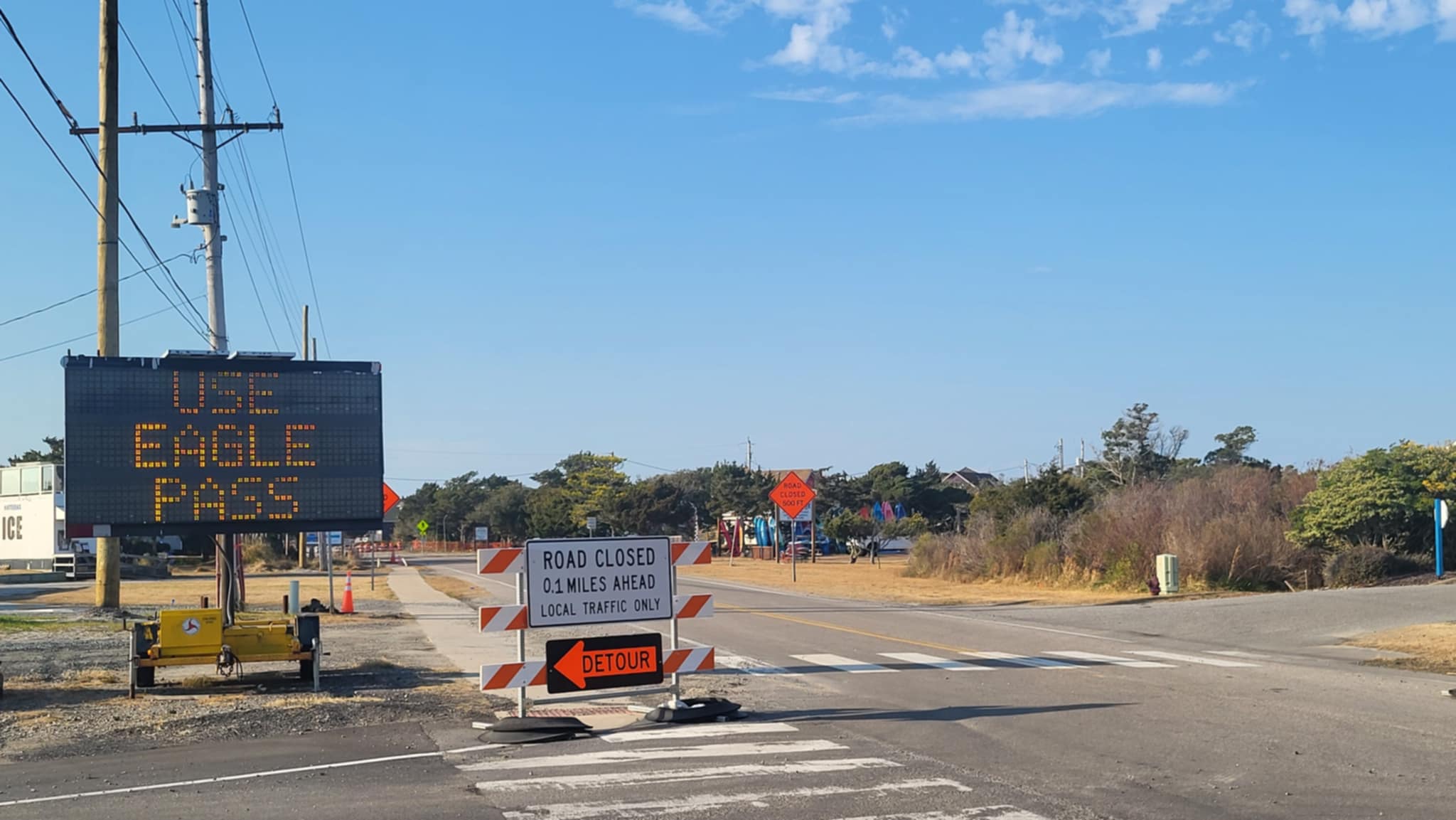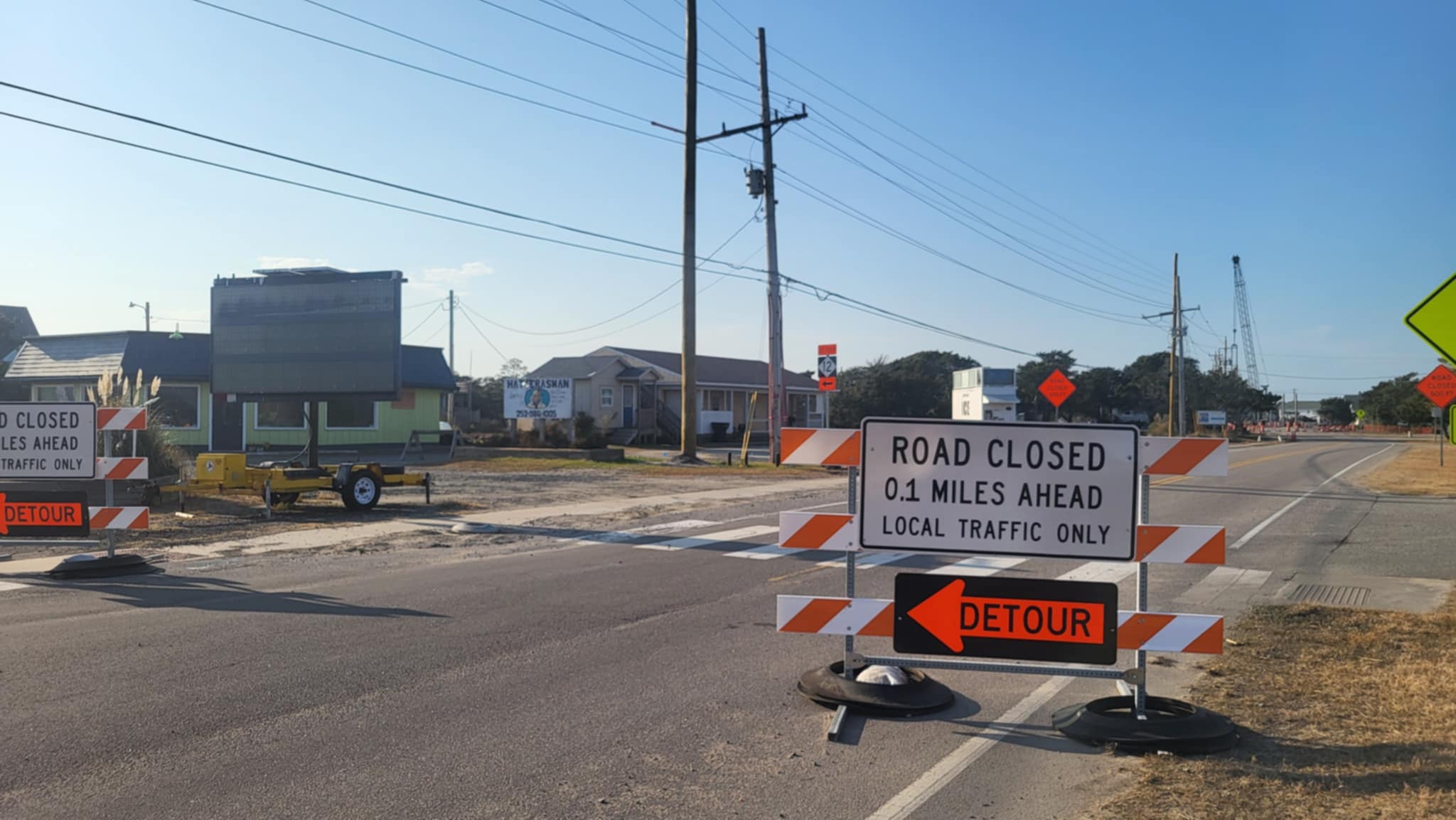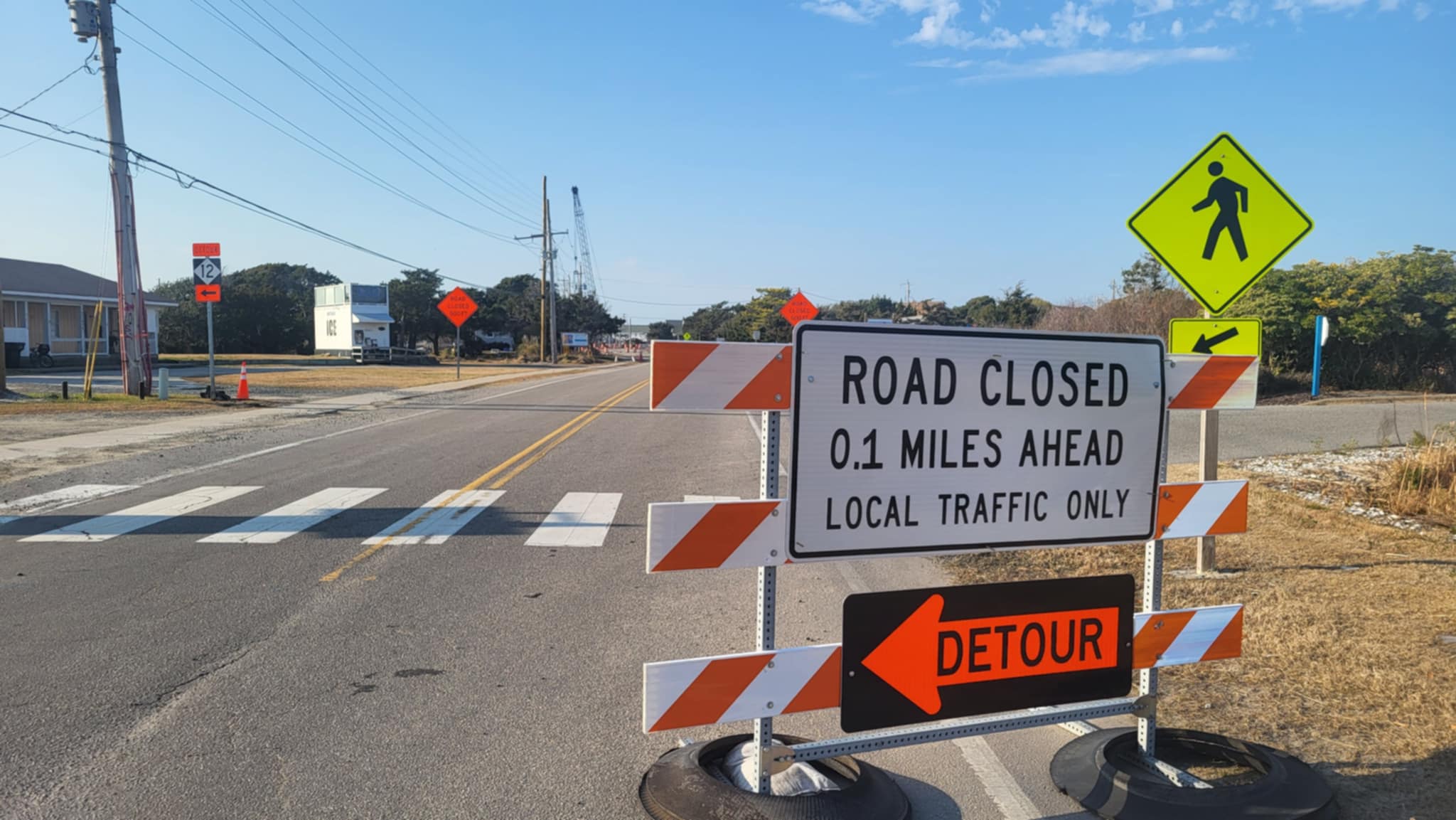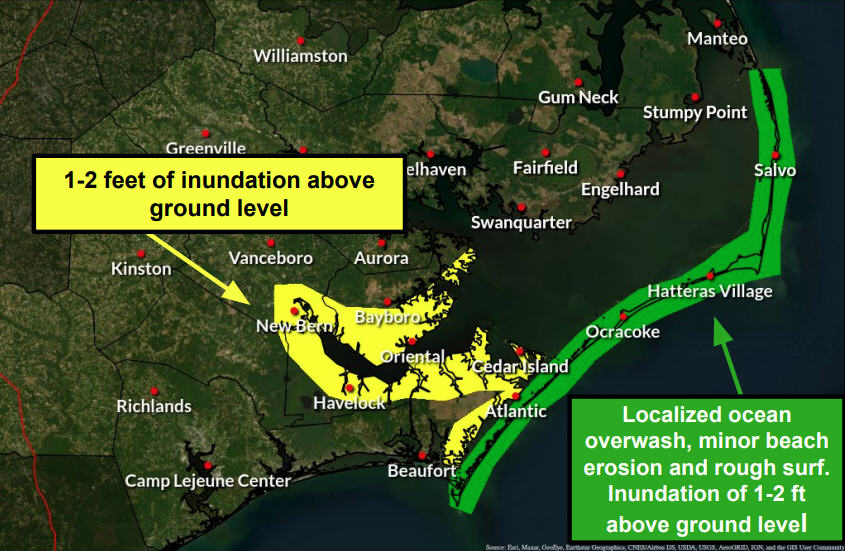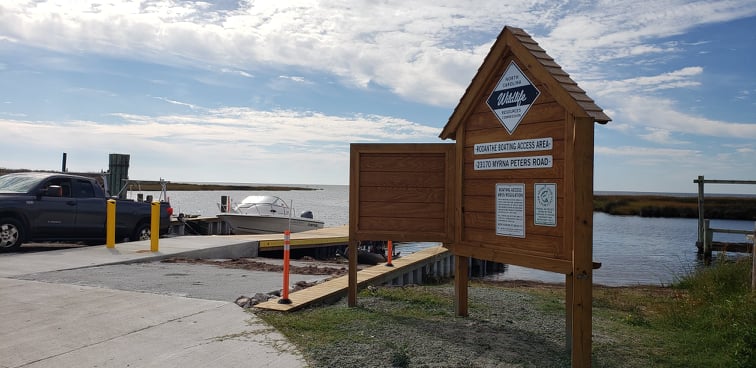Jones introduces bill to overturn both ORV
U.S. Rep. Walter B. Jones, R-N.C., today introduced a bill in House of Representatives that seeks to overturn both the National Park Service’s final rule for off-road vehicles on the Cape Hatteras National Seashore and a court-approved consent decree that settled a lawsuit filed against the Park Service by environmental groups.
U.S. Rep. Walter B. Jones, R-N.C., today introduced a bill in House of Representatives that seeks to overturn both the National Park Service’s final rule for off-road vehicles on the Cape Hatteras National Seashore and a court-approved consent decree that settled a lawsuit filed against the Park Service by environmental groups.
U.S. Rep. Walter B. Jones, R-N.C., today introduced a bill in House of Representatives that seeks to overturn both the National Park Service’s final rule for off-road vehicles on the Cape Hatteras National Seashore and a court-approved consent decree that settled a lawsuit filed against the Park Service by environmental groups.
U.S. Rep. Walter B. Jones, R-N.C., today introduced a bill in House of Representatives that seeks to overturn both the National Park Service’s final rule for off-road vehicles on the Cape Hatteras National Seashore and a court-approved consent decree that settled a lawsuit filed against the Park Service by environmental groups.
The Preserving Access to the Cape Hatteras National Seashore Recreational Area Act would return management of seashore resources to the Interim Protected Species Management Strategy and Environmental Assessment, issued by the Park Service on June 13, 2007.
In a media release, Jones said the bill would “restore reasonable pedestrian and motorized access” to the seashore.
The interim strategy, the release notes, was backed up by a 113-page Biological Opinion issued by the U.S. Fish and Wildlife Service, which found that the plan would not jeopardize the species of concern, namely piping plovers and sea turtles.
The Preserving Access to the Cape Hatteras National Seashore Recreational Area Act would return management of seashore resources to the Interim Protected Species Management Strategy and Environmental Assessment, issued by the Park Service on June 13, 2007.
In a media release, Jones said the bill would “restore reasonable pedestrian and motorized access” to the seashore.
The interim strategy, the release notes, was backed up by a 113-page Biological Opinion issued by the U.S. Fish and Wildlife Service, which found that the plan would not jeopardize the species of concern, namely piping plovers and sea turtles.
The Preserving Access to the Cape Hatteras National Seashore Recreational Area Act would return management of seashore resources to the Interim Protected Species Management Strategy and Environmental Assessment, issued by the Park Service on June 13, 2007.
In a media release, Jones said the bill would “restore reasonable pedestrian and motorized access” to the seashore.
The interim strategy, the release notes, was backed up by a 113-page Biological Opinion issued by the U.S. Fish and Wildlife Service, which found that the plan would not jeopardize the species of concern, namely piping plovers and sea turtles.
The Preserving Access to the Cape Hatteras National Seashore Recreational Area Act would return management of seashore resources to the Interim Protected Species Management Strategy and Environmental Assessment, issued by the Park Service on June 13, 2007.
In a media release, Jones said the bill would “restore reasonable pedestrian and motorized access” to the seashore.
The interim strategy, the release notes, was backed up by a 113-page Biological Opinion issued by the U.S. Fish and Wildlife Service, which found that the plan would not jeopardize the species of concern, namely piping plovers and sea turtles.
“The federal government needs to remember that Cape Hatteras was established to be a recreational area for the American people,” Congressman Jones said in a statement issued by his office. “But taxpayers can’t recreate without access to the beach. The goal of management ought to be a balanced approach between visitor access and species protection. The Final Rule falls short of that goal. The interim strategy comes much closer to hitting the target.”
“The federal government needs to remember that Cape Hatteras was established to be a recreational area for the American people,” Congressman Jones said in a statement issued by his office. “But taxpayers can’t recreate without access to the beach. The goal of management ought to be a balanced approach between visitor access and species protection. The Final Rule falls short of that goal. The interim strategy comes much closer to hitting the target.”
“The federal government needs to remember that Cape Hatteras was established to be a recreational area for the American people,” Congressman Jones said in a statement issued by his office. “But taxpayers can’t recreate without access to the beach. The goal of management ought to be a balanced approach between visitor access and species protection. The Final Rule falls short of that goal. The interim strategy comes much closer to hitting the target.”
“The federal government needs to remember that Cape Hatteras was established to be a recreational area for the American people,” Congressman Jones said in a statement issued by his office. “But taxpayers can’t recreate without access to the beach. The goal of management ought to be a balanced approach between visitor access and species protection. The Final Rule falls short of that goal. The interim strategy comes much closer to hitting the target.”
H.R. 4094 specifies that the Secretary of the Department of the Interior cannot impose additional restrictions on pedestrian or motorized access to the seashore other than those specified in the interim strategy or specifically authorized by the legislation.
H.R. 4094 specifies that the Secretary of the Department of the Interior cannot impose additional restrictions on pedestrian or motorized access to the seashore other than those specified in the interim strategy or specifically authorized by the legislation.
H.R. 4094 specifies that the Secretary of the Department of the Interior cannot impose additional restrictions on pedestrian or motorized access to the seashore other than those specified in the interim strategy or specifically authorized by the legislation.
H.R. 4094 specifies that the Secretary of the Department of the Interior cannot impose additional restrictions on pedestrian or motorized access to the seashore other than those specified in the interim strategy or specifically authorized by the legislation.
Any additional restrictions, the bill says, must be based on peer-reviewed science and be open to public comment.
Any additional restrictions, the bill says, must be based on peer-reviewed science and be open to public comment.
Any additional restrictions, the bill says, must be based on peer-reviewed science and be open to public comment.
Any additional restrictions, the bill says, must be based on peer-reviewed science and be open to public comment.
Additional restrictions are allowed only to protect species listed as endangered under the Endangered Species Act and they must restrict recreational activities for the least possible time on the smallest possible portions of the beach.
Additional restrictions are allowed only to protect species listed as endangered under the Endangered Species Act and they must restrict recreational activities for the least possible time on the smallest possible portions of the beach.
Additional restrictions are allowed only to protect species listed as endangered under the Endangered Species Act and they must restrict recreational activities for the least possible time on the smallest possible portions of the beach.
Additional restrictions are allowed only to protect species listed as endangered under the Endangered Species Act and they must restrict recreational activities for the least possible time on the smallest possible portions of the beach.
Restrictions for endangered species must not be greater than restrictions in effect for that species at any other national seashore.
Restrictions for endangered species must not be greater than restrictions in effect for that species at any other national seashore.
Restrictions for endangered species must not be greater than restrictions in effect for that species at any other national seashore.
Restrictions for endangered species must not be greater than restrictions in effect for that species at any other national seashore.
And, finally, to the maximum extent possible, the secretary must designate pedestrian and vehicle corridors of minimal distance around any additional restricted areas to allow access to areas that are not closed.
And, finally, to the maximum extent possible, the secretary must designate pedestrian and vehicle corridors of minimal distance around any additional restricted areas to allow access to areas that are not closed.
And, finally, to the maximum extent possible, the secretary must designate pedestrian and vehicle corridors of minimal distance around any additional restricted areas to allow access to areas that are not closed.
And, finally, to the maximum extent possible, the secretary must designate pedestrian and vehicle corridors of minimal distance around any additional restricted areas to allow access to areas that are not closed.
The legislation specifies that the interim plan will remain in effect until the secretary issues a new final rule that meets the requirements on restrictions set forth in the bill.
The legislation specifies that the interim plan will remain in effect until the secretary issues a new final rule that meets the requirements on restrictions set forth in the bill.
The legislation specifies that the interim plan will remain in effect until the secretary issues a new final rule that meets the requirements on restrictions set forth in the bill.
The legislation specifies that the interim plan will remain in effect until the secretary issues a new final rule that meets the requirements on restrictions set forth in the bill.
H.R. 4094 was greeted warmly by the Cape Hatteras Access Preservation Alliance (CHAPA), a grassroots organizations committed to balancing recreational access with resource management.
H.R. 4094 was greeted warmly by the Cape Hatteras Access Preservation Alliance (CHAPA), a grassroots organizations committed to balancing recreational access with resource management.
H.R. 4094 was greeted warmly by the Cape Hatteras Access Preservation Alliance (CHAPA), a grassroots organizations committed to balancing recreational access with resource management.
H.R. 4094 was greeted warmly by the Cape Hatteras Access Preservation Alliance (CHAPA), a grassroots organizations committed to balancing recreational access with resource management.
“We appreciate the efforts of Congressman Jones and the leadership he has shown for preserving access to this American treasure, so it can continue to be used by the people for its intended recreational purpose,” said CHAPA president John Couch in a media release.
“We appreciate the efforts of Congressman Jones and the leadership he has shown for preserving access to this American treasure, so it can continue to be used by the people for its intended recreational purpose,” said CHAPA president John Couch in a media release.
“We appreciate the efforts of Congressman Jones and the leadership he has shown for preserving access to this American treasure, so it can continue to be used by the people for its intended recreational purpose,” said CHAPA president John Couch in a media release.
“We appreciate the efforts of Congressman Jones and the leadership he has shown for preserving access to this American treasure, so it can continue to be used by the people for its intended recreational purpose,” said CHAPA president John Couch in a media release.
The release says access to the seashore has been “severely limited” by the Park Service’s final ORV plan and rule, which became effective on Feb. 15.
The release says access to the seashore has been “severely limited” by the Park Service’s final ORV plan and rule, which became effective on Feb. 15.
The release says access to the seashore has been “severely limited” by the Park Service’s final ORV plan and rule, which became effective on Feb. 15.
The release says access to the seashore has been “severely limited” by the Park Service’s final ORV plan and rule, which became effective on Feb. 15.
“The Cape Hatteras National Seashore Recreational Area,” CHAPA says, “has been a popular destination for American families seeking affordable, family-oriented beach vacations. Under the final rule, access to some of the most popular areas is no longer available. This has restricted access for many, including the disabled and elderly, and caused financial harm to the communities surrounding the seashore.”
“The Cape Hatteras National Seashore Recreational Area,” CHAPA says, “has been a popular destination for American families seeking affordable, family-oriented beach vacations. Under the final rule, access to some of the most popular areas is no longer available. This has restricted access for many, including the disabled and elderly, and caused financial harm to the communities surrounding the seashore.”
“The Cape Hatteras National Seashore Recreational Area,” CHAPA says, “has been a popular destination for American families seeking affordable, family-oriented beach vacations. Under the final rule, access to some of the most popular areas is no longer available. This has restricted access for many, including the disabled and elderly, and caused financial harm to the communities surrounding the seashore.”
“The Cape Hatteras National Seashore Recreational Area,” CHAPA says, “has been a popular destination for American families seeking affordable, family-oriented beach vacations. Under the final rule, access to some of the most popular areas is no longer available. This has restricted access for many, including the disabled and elderly, and caused financial harm to the communities surrounding the seashore.”
Jones’ legislation was filed on the heels of a lawsuit that CHAPA filed earlier this month in federal court in Washington, D.C., challenging the final plan and regulation, mostly on the basis that the process was flawed.
The 2007 Interim Protected Species Management Plan and Environmental Assessment was a publicly vetted plan for managing the seashore until an ORV plan and final rule were written.
At the time, the Park Service envisioned that the details of that plan would be worked out by seashore stakeholders in a negotiated rulemaking committee.
However, before that committee officially began its work and just months after the publication of the interim plan, a lawsuit was filed against the Park Service by Defenders of Wildlife and National Audubon Society, represented by the Southern Environmental Law Canter.
The lawsuit claimed that the Park Service was allowing ORV use on the seashore without a plan and rule, which are required by law, and that the interim plan did not adequately protect nesting shorebirds and turtles.
Dare and Hyde counties and CHAPA were allowed by the court to enter the case as defendant-intervenors.
Federal District Court Judge Terrence Boyle made it clear that he considered that without a plan, ORVs were operating illegally on the seashore and that he was prepared to stop vehicle use on the beaches.
After that, in April, 2008, all parties to the lawsuit signed off on a consent decree that modified the interim plan to include much larger closures and protections for birds and turtles than had been used by the Park Service in the past.
The seashore was to operate under the terms of the consent decree until there was a final plan and regulation.
The negotiated rulemaking committee ended its work in the winter of 2009 without reaching a consensus on the details of the final plan.
The Park Service then began the work of developing an Environmental Impact Statement and final ORV plan and special regulation with several public comment periods along the way.
That final regulation was published in January and became effect Feb. 15.
Because of the CHAPA lawsuit seeking to overturn the final rule, the consent decree, set to expire on Feb. 15, was kept in place by Boyle at a status hearing in his court last week.
The park continues to operate under the ORV plan and final rule as the CHAPA case proceeds in Washington.
This is Jones’ third attempt to overturn the consent decree through legislation.
In June, 2008, he introduced a bill in the House to return the seashore’s management to the interim plan. A bill was concurrently introduced in the Senate by Sen. Richard Burr, R-N.C., and then Sen. Elizabeth Dole, also a Republican.
That bill had hearing in a Senate committee and a House subcommittee and died when the Senate committee refused to send the bill to the floor for a vote.
Jones introduced his bill again in January, 2009. It was referred to committee, where no action was ever taken.
The current bill, H.R. 4094, is much more detailed than the first two and has been sent to the House Natural Resources Committee.
Today, Jim Keene, a director of the North Carolina Beach Buggy Association, emphasized the importance of people getting involved throughout the United States.
He explained, “The Cape Hatteras National Seashore Recreational Area is controlled by Congress. That is why it is vital that people everyone contact their elected leaders in Washington now and ask them to support House Bill 4094.”
Coincidentally, a grassroots effort has gotten underway on the popular website, Change.org., to get Congress to overturn the final rule.
That petition to members of Congress has been signed by more than 12,000 people in just a little more than a week.
FOR MORE INFORMATION
Click here to read H.R. 4094, introduced today by U.S. Rep. Walter B. Jones
The Interim Protected Species Management Strategy is available on the park planning website at http://parkplanning.nps.gov/document.cfm?parkID=358&projectID=13331&documentID=19796
The Change.org petition can be found at http://www.change.org/petitions/the-us-senate-remove-the-orv-rule-and-provide-free-and-open-access
Other articles on the effort by the Park Service to formulate an ORV plan and final rule can be found on the Island Free Press website. Go to the bottom of the Front Page, click on the Archives bar. From there, you can look for past stories by year on the Beach Access and Park Issues Page.
Jones’ legislation was filed on the heels of a lawsuit that CHAPA filed earlier this month in federal court in Washington, D.C., challenging the final plan and regulation, mostly on the basis that the process was flawed.
The 2007 Interim Protected Species Management Plan and Environmental Assessment was a publicly vetted plan for managing the seashore until an ORV plan and final rule were written.
At the time, the Park Service envisioned that the details of that plan would be worked out by seashore stakeholders in a negotiated rulemaking committee.
However, before that committee officially began its work and just months after the publication of the interim plan, a lawsuit was filed against the Park Service by Defenders of Wildlife and National Audubon Society, represented by the Southern Environmental Law Canter.
The lawsuit claimed that the Park Service was allowing ORV use on the seashore without a plan and rule, which are required by law, and that the interim plan did not adequately protect nesting shorebirds and turtles.
Dare and Hyde counties and CHAPA were allowed by the court to enter the case as defendant-intervenors.
Federal District Court Judge Terrence Boyle made it clear that he considered that without a plan, ORVs were operating illegally on the seashore and that he was prepared to stop vehicle use on the beaches.
After that, in April, 2008, all parties to the lawsuit signed off on a consent decree that modified the interim plan to include much larger closures and protections for birds and turtles than had been used by the Park Service in the past.
The seashore was to operate under the terms of the consent decree until there was a final plan and regulation.
The negotiated rulemaking committee ended its work in the winter of 2009 without reaching a consensus on the details of the final plan.
The Park Service then began the work of developing an Environmental Impact Statement and final ORV plan and special regulation with several public comment periods along the way.
That final regulation was published in January and became effect Feb. 15.
Because of the CHAPA lawsuit seeking to overturn the final rule, the consent decree, set to expire on Feb. 15, was kept in place by Boyle at a status hearing in his court last week.
The park continues to operate under the ORV plan and final rule as the CHAPA case proceeds in Washington.
This is Jones’ third attempt to overturn the consent decree through legislation.
In June, 2008, he introduced a bill in the House to return the seashore’s management to the interim plan. A bill was concurrently introduced in the Senate by Sen. Richard Burr, R-N.C., and then Sen. Elizabeth Dole, also a Republican.
That bill had hearing in a Senate committee and a House subcommittee and died when the Senate committee refused to send the bill to the floor for a vote.
Jones introduced his bill again in January, 2009. It was referred to committee, where no action was ever taken.
The current bill, H.R. 4094, is much more detailed than the first two and has been sent to the House Natural Resources Committee.
Today, Jim Keene, a director of the North Carolina Beach Buggy Association, emphasized the importance of people getting involved throughout the United States.
He explained, “The Cape Hatteras National Seashore Recreational Area is controlled by Congress. That is why it is vital that people everyone contact their elected leaders in Washington now and ask them to support House Bill 4094.”
Coincidentally, a grassroots effort has gotten underway on the popular website, Change.org., to get Congress to overturn the final rule.
That petition to members of Congress has been signed by more than 12,000 people in just a little more than a week.
FOR MORE INFORMATION
Click here to read H.R. 4094, introduced today by U.S. Rep. Walter B. Jones
The Interim Protected Species Management Strategy is available on the park planning website at http://parkplanning.nps.gov/document.cfm?parkID=358&projectID=13331&documentID=19796
The Change.org petition can be found at http://www.change.org/petitions/the-us-senate-remove-the-orv-rule-and-provide-free-and-open-access
Other articles on the effort by the Park Service to formulate an ORV plan and final rule can be found on the Island Free Press website. Go to the bottom of the Front Page, click on the Archives bar. From there, you can look for past stories by year on the Beach Access and Park Issues Page.
Jones’ legislation was filed on the heels of a lawsuit that CHAPA filed earlier this month in federal court in Washington, D.C., challenging the final plan and regulation, mostly on the basis that the process was flawed.
The 2007 Interim Protected Species Management Plan and Environmental Assessment was a publicly vetted plan for managing the seashore until an ORV plan and final rule were written.
At the time, the Park Service envisioned that the details of that plan would be worked out by seashore stakeholders in a negotiated rulemaking committee.
However, before that committee officially began its work and just months after the publication of the interim plan, a lawsuit was filed against the Park Service by Defenders of Wildlife and National Audubon Society, represented by the Southern Environmental Law Canter.
The lawsuit claimed that the Park Service was allowing ORV use on the seashore without a plan and rule, which are required by law, and that the interim plan did not adequately protect nesting shorebirds and turtles.
Dare and Hyde counties and CHAPA were allowed by the court to enter the case as defendant-intervenors.
Federal District Court Judge Terrence Boyle made it clear that he considered that without a plan, ORVs were operating illegally on the seashore and that he was prepared to stop vehicle use on the beaches.
After that, in April, 2008, all parties to the lawsuit signed off on a consent decree that modified the interim plan to include much larger closures and protections for birds and turtles than had been used by the Park Service in the past.
The seashore was to operate under the terms of the consent decree until there was a final plan and regulation.
The negotiated rulemaking committee ended its work in the winter of 2009 without reaching a consensus on the details of the final plan.
The Park Service then began the work of developing an Environmental Impact Statement and final ORV plan and special regulation with several public comment periods along the way.
That final regulation was published in January and became effect Feb. 15.
Because of the CHAPA lawsuit seeking to overturn the final rule, the consent decree, set to expire on Feb. 15, was kept in place by Boyle at a status hearing in his court last week.
The park continues to operate under the ORV plan and final rule as the CHAPA case proceeds in Washington.
This is Jones’ third attempt to overturn the consent decree through legislation.
In June, 2008, he introduced a bill in the House to return the seashore’s management to the interim plan. A bill was concurrently introduced in the Senate by Sen. Richard Burr, R-N.C., and then Sen. Elizabeth Dole, also a Republican.
That bill had hearing in a Senate committee and a House subcommittee and died when the Senate committee refused to send the bill to the floor for a vote.
Jones introduced his bill again in January, 2009. It was referred to committee, where no action was ever taken.
The current bill, H.R. 4094, is much more detailed than the first two and has been sent to the House Natural Resources Committee.
Today, Jim Keene, a director of the North Carolina Beach Buggy Association, emphasized the importance of people getting involved throughout the United States.
He explained, “The Cape Hatteras National Seashore Recreational Area is controlled by Congress. That is why it is vital that people everyone contact their elected leaders in Washington now and ask them to support House Bill 4094.”
Coincidentally, a grassroots effort has gotten underway on the popular website, Change.org., to get Congress to overturn the final rule.
That petition to members of Congress has been signed by more than 12,000 people in just a little more than a week.
FOR MORE INFORMATION
Click here to read H.R. 4094, introduced today by U.S. Rep. Walter B. Jones
The Interim Protected Species Management Strategy is available on the park planning website at http://parkplanning.nps.gov/document.cfm?parkID=358&projectID=13331&documentID=19796
The Change.org petition can be found at http://www.change.org/petitions/the-us-senate-remove-the-orv-rule-and-provide-free-and-open-access
Other articles on the effort by the Park Service to formulate an ORV plan and final rule can be found on the Island Free Press website. Go to the bottom of the Front Page, click on the Archives bar. From there, you can look for past stories by year on the Beach Access and Park Issues Page.
Jones’ legislation was filed on the heels of a lawsuit that CHAPA filed earlier this month in federal court in Washington, D.C., challenging the final plan and regulation, mostly on the basis that the process was flawed.
The 2007 Interim Protected Species Management Plan and Environmental Assessment was a publicly vetted plan for managing the seashore until an ORV plan and final rule were written.
At the time, the Park Service envisioned that the details of that plan would be worked out by seashore stakeholders in a negotiated rulemaking committee.
However, before that committee officially began its work and just months after the publication of the interim plan, a lawsuit was filed against the Park Service by Defenders of Wildlife and National Audubon Society, represented by the Southern Environmental Law Canter.
The lawsuit claimed that the Park Service was allowing ORV use on the seashore without a plan and rule, which are required by law, and that the interim plan did not adequately protect nesting shorebirds and turtles.
Dare and Hyde counties and CHAPA were allowed by the court to enter the case as defendant-intervenors.
Federal District Court Judge Terrence Boyle made it clear that he considered that without a plan, ORVs were operating illegally on the seashore and that he was prepared to stop vehicle use on the beaches.
After that, in April, 2008, all parties to the lawsuit signed off on a consent decree that modified the interim plan to include much larger closures and protections for birds and turtles than had been used by the Park Service in the past.
The seashore was to operate under the terms of the consent decree until there was a final plan and regulation.
The negotiated rulemaking committee ended its work in the winter of 2009 without reaching a consensus on the details of the final plan.
The Park Service then began the work of developing an Environmental Impact Statement and final ORV plan and special regulation with several public comment periods along the way.
That final regulation was published in January and became effect Feb. 15.
Because of the CHAPA lawsuit seeking to overturn the final rule, the consent decree, set to expire on Feb. 15, was kept in place by Boyle at a status hearing in his court last week.
The park continues to operate under the ORV plan and final rule as the CHAPA case proceeds in Washington.
This is Jones’ third attempt to overturn the consent decree through legislation.
In June, 2008, he introduced a bill in the House to return the seashore’s management to the interim plan. A bill was concurrently introduced in the Senate by Sen. Richard Burr, R-N.C., and then Sen. Elizabeth Dole, also a Republican.
That bill had hearing in a Senate committee and a House subcommittee and died when the Senate committee refused to send the bill to the floor for a vote.
Jones introduced his bill again in January, 2009. It was referred to committee, where no action was ever taken.
The current bill, H.R. 4094, is much more detailed than the first two and has been sent to the House Natural Resources Committee.
Today, Jim Keene, a director of the North Carolina Beach Buggy Association, emphasized the importance of people getting involved throughout the United States.
He explained, “The Cape Hatteras National Seashore Recreational Area is controlled by Congress. That is why it is vital that people everyone contact their elected leaders in Washington now and ask them to support House Bill 4094.”
Coincidentally, a grassroots effort has gotten underway on the popular website, Change.org., to get Congress to overturn the final rule.
That petition to members of Congress has been signed by more than 12,000 people in just a little more than a week.
FOR MORE INFORMATION
Click here to read H.R. 4094, introduced today by U.S. Rep. Walter B. Jones
The Interim Protected Species Management Strategy is available on the park planning website at http://parkplanning.nps.gov/document.cfm?parkID=358&projectID=13331&documentID=19796
The Change.org petition can be found at http://www.change.org/petitions/the-us-senate-remove-the-orv-rule-and-provide-free-and-open-access
Other articles on the effort by the Park Service to formulate an ORV plan and final rule can be found on the Island Free Press website. Go to the bottom of the Front Page, click on the Archives bar. From there, you can look for past stories by year on the Beach Access and Park Issues Page.
Subject
Name
(required, will not be published)
(required, will not be published)
City :
State :
Your Comments:
May be posted on the Letters to the Editor page at the discretion of the editor.
May be posted on the Letters to the Editor page at the discretion of the editor.
May be posted on the Letters to the Editor page at the discretion of the editor.
May be posted on the Letters to the Editor page at the discretion of the editor.










